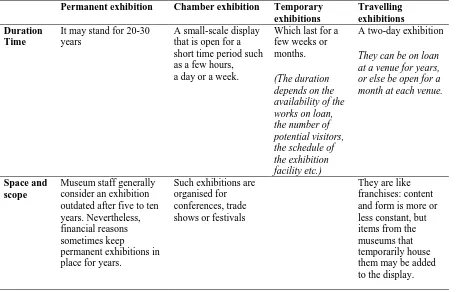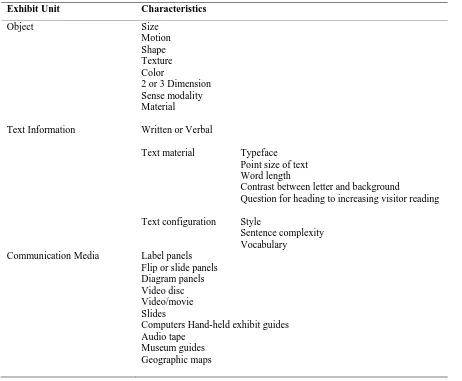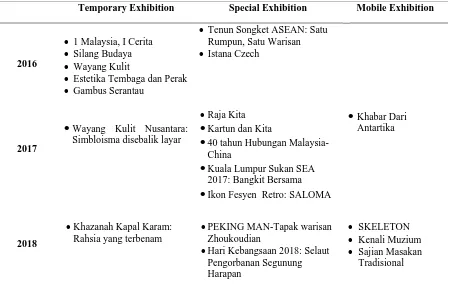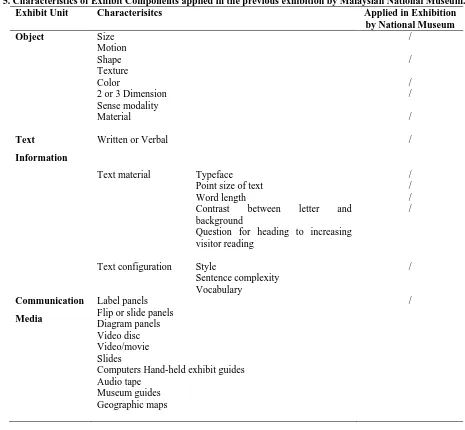An Empirical Understanding On Types Of Museum
Exhibition Design
Norfadilah Kamaruddin1 1 Creative Visual Exchange Group (CREaTE),
Faculty of Art & Design, University Teknologi MARA (UiTM), Shah Alam, Selangor, Malaysia
dilagiant@gmail.com
DOI: 10.29322/IJSRP.9.10.2019.p9470
http://dx.doi.org/10.29322/IJSRP.9.10.2019.p9470
ABSTRACT— A graphic designer is highly requirement to select the right visual elements in designing an exhibition design for a museum. This is to ensure an exhibition successful in contact with the visitors. In the case of exhibition design for the Malaysian National Museum, a multidisciplinary process used as an integrated approach by working with various disciplines.
By examining the design process of the existing exhibition for the Malaysian National Museum, this paper revealed an extensive types of exhibition as an example for comprehending the complexity of an exhibition design for museum in Malaysia.
Keywords— interface design, museum exhibition, design process, exhibition design, museum stuides
1. INTRODUCTION
Museum also known as an entity that dedicated to public service and, consequently, their relationship with their audience is the core of interest. Moreover, museum commonly is classified into five basic types which are natural history and natural science, science and technology, history, art and a recent kind of museum is the virtual museum. Within this, many extensive researches have been conducted on museum audiences or visitors, their characteristics, needs and expectations (Classen, 2007; Smith & Tinio, 2008; Bickford, 2010). However, the way interface design towards new technologies in the museum environment impact museum audiences’ experiences has only recently started to be covered.
For the discipline of Interface Design for the museum, the use of interactive technologies towards effectives interfaces in the exhibition environment is a rich area of research as these technologies are significantly changing the way visitors experience their museum visits (Lorenc, Skolnick and Berger, 2007). In this sense, considering the different perspectives on the current role and concept of museums, this research paper aims to examining the design process of the existing exhibition for the Malaysian National Museum and further extensively understand on the type of exhibitions and its interface design characteristics at the Malaysian National Museum. The complexity of an exhibition design discovered in this paper as an example for comprehending for museum in Malaysia.
2. THE BACKGROUND
2.2 THE MALAYSIAN NATIONAL MUSEUM
The National Museum is the premier museum in Malaysia and is one of the most famous museums in Southeast Asia. Preliminary, it was officially opened on 31 August 1963, the National Museum has undergone constant changes in terms of exhibitions, organizational structures and activities. The size of National Museum is 362 feet long and 124 feet wide. This museum building is built with two large murals on the front to reflect the tradition of national arts and culture. The architecture of this National Museum building is supported by 26 pillars concrete that have been renovated to retaining the characteristics of traditional Malay palaces. The concept of 26 columns is based on a combination of 13 columns on the east and 13 piles on the west side of the building, which symbolizes Malaysia is formed from 13 states.
Beside ‘Balai C’ is the forth hall called 'Balai D' which showcases materials that related to the Malaysian's economic activities such as industry commercial and public transport. Meanwhile, the centre piece of the National Museum is used as a place to hold a temporary exhibition. Figure 1 shows the floor plan of the gallery at Malaysian National Museum.
Figure 1: The floor plan of four galleries at the Malaysia National Museum
2.3 TYPES OF MUSEUM EXHIBITION DESIGN
According to Lorenc, Skolnick and Berger (2007), exhibition design is an environment that communicates the content through medium of graphic design. Moreover, Demir (2009) has added that exhibition design as a new branch to its design categories. This new branch has many types and it is can be varied from public centres, visitor centres, institutional centres, trade shows, parks and heritage centres, art galleries, showrooms, traveling exhibitions to museums.
On the other hand, peoples are normally recognized the term of museum as a place or a building that stores old materials. But this traditional view moreover has been increasingly growing as the UNESCO through a professional body called ICOM (International Council of Museums Members) has given a new definition for the museum. Accordingly, the museum has been defined as a permanent and non-profit institution, in which it is always open to the public for the purpose of research and education.
As an educational exhibition purpose, the museum visitor to an exhibition is free to wander through an environment rich in sensory stimulation, where attention to one object or message may compete with another (Bitgood & Patterson,1993). And as we all know that the traditional functions of the museum are including an activity such as collecting, researching, translating, documenting, preserving, and exhibiting. Nevertheless, as technology rapidly changing, the role of the museum has changed considerably. Moreover, museum concept also changed from Object Oriented (which focusing more on services pleasure) to Information Delivery (concentrating on enjoyment and edutainment). Figure 2 shows the changes from Object Oriented to Information Delivery.
Traditional
function
Modern function
[image:2.595.147.447.93.254.2]Basic Object Display Educational Display
Figure 2: The changes role of museum from Object Oriented to Information Content Delivery.
One of the main functions of a museum is organizing and displaying the selected items into a meaningful story (Neal, 1987). Towards this role, museums also have been eager to innovate in the application of digital technology to the display of museum content with the aim of enhancing visitor experience (Tallon & Walker, 2008). As Hooper-Greenhill (1994) stated that
museum through an exhibition design must communicate a statement with the audience and transmit the information technologically, so museums must find ways of presentation collections of museums. So, the vital role of the exhibition designer is to focus on the story of the exhibition. The secondary focus, Erkmen (2004) points will be on using the space, displays, materials and the harmony of the design elements with these. Hence, the understanding of an exhibition as an interface design of the collections content is highly required by all parties involved at the museum.
Object Content
[image:2.595.45.529.563.663.2]Talking about an interface design of museum exhibition, the appearance or display between the visitor and the museum exhibition is called interface design. In this sense, the exhibition works as a medium with an effective interface for the collections, depots and research. Thus, a visit to an exhibition counts as a good use of leisure time, and some exhibitions are almost overrun with visitors. In relation, interface design of an exhibition at the museum are divided into four namely presentation interface, conversation interface, navigation interface and explanation interface. Within this understanding, for museum exhibition, a broad literature established there are four common types namely permanent exhibition, chamber exhibition, temporary exhibition and travelling exhibition. All these types are based on duration of time be exhibit, space involved and scope of exhibition. The summary of it as per shows in Table 1 below.
Table 1. Types of exhibition from broad literature.
Permanent exhibition Chamber exhibition Temporary exhibitions
Travelling exhibitions Duration
Time
It may stand for 20-30 years
A small-scale display that is open for a short time period such as a few hours, a day or a week.
Which last for a few weeks or months.
(The duration depends on the availability of the works on loan, the number of potential visitors, the schedule of the exhibition facility etc.)
A two-day exhibition
They can be on loan at a venue for years, or else be open for a month at each venue.
Space and scope
Museum staff generally consider an exhibition outdated after five to ten years. Nevertheless, financial reasons sometimes keep
permanent exhibitions in place for years.
Such exhibitions are organised for conferences, trade shows or festivals
They are like franchises: content and form is more or less constant, but items from the museums that temporarily house them may be added to the display.
In this article, the exhibit unit (display) is defined as a combination of two factors: exhibit components, and the configuration or relationships among these components. Figure 3 illustrates these two factors comprising an exhibit unit. An exhibit unit is made up of one or more of the following components: (1) exhibit objects; (2) a communication media (presentation) and (3) text information to be communicated (it is involving the use of language). Therefore, all of these three components are not necessarily having to be included in all exhibition. For example, some exhibits include only media and text information (e.g., an exhibition through interactive computer).
Exhibit Components Exhibit Configuration
Object Spatial Relationships
Text Information Others Relationship (size, colour)
Communication Media
[image:3.595.56.471.604.749.2]Exhibit objects might comprise a painting, a sculpture, a piece of furniture, or also a manuscript. Therefore, the exhibit object it all depending’s to the types of exhibition material. While, according to the viewpoint in this article, an exhibit object is defined as a visible or tangible thing that does not present text information. For example, art museum commonly emphasis paintings and sculpture as an exhibit objects due to visitors generally preferred. While others museum more preferred a visible thing such as an interactive computer to emphasize the meaning that objects communicate to visitors. Moreover, to understand the impact of exhibits object on people, we must understand which characteristics of exhibit objects, text information and communication media have the strongest impact on visitors. Table 2 provides a list of a few of the characteristics for exhibition components that are likely to have a significant impact on visitors.
Table 2. Characteristics of Exhibit Components
Exhibit Unit Characteristics
Object Size
Motion Shape Texture Color
2 or 3 Dimension Sense modality Material
Text Information Written or Verbal
Text material Typeface Point size of text Word length
Contrast between letter and background
Question for heading to increasing visitor reading
Text configuration Style
Sentence complexity Vocabulary
Communication Media Label panels Flip or slide panels Diagram panels Video disc Video/movie Slides
Computers Hand-held exhibit guides Audio tape
Museum guides Geographic maps
3. TYPES OF EXHIBITION DESIGN AT THE MALAYSIAN NATIONAL MUSEUM
Analysis on the document provided by the Exhibition Unit, Department of Museum Malaysia, exhibitions could be characterized by content, genre, venue, or the type of audience to focus on. In term of exhibitions types at the museum, it is classified into 4 types of exhibition performs by the Department of Museum Malaysia counting Permanent Exhibition, Temporary Exhibition, Special Exhibition and Mobile Exhibition. All that exhibitions moreover have a duration of time show or display, organised and aim to communicate a message through engaging their audiences in meaningful and compelling interactions. The duration of an exhibition varies from a very short time (one or two days) extent up to months, years and decades. The summary of exhibition types by the Department of Museum Malaysia as per shows in Table 3.
Table 3. Types of exhibitions by the Department of Museum Malaysia
1. Hall A: Pre- history gallery
2. Hall B: The Malay Kingdoms
3. Hall C: Colonial Era 4. Hall D: Malaysia Now
Themed temporary exhibition
Which last for a few weeks or months.
Outreach show
[image:5.595.36.491.253.543.2]Towards these 4 types of exhibition, analysis on the report of exhibition documents from 2016 to 2018 provided by the Exhibition Unit, Department of Museum Malaysia, a number of exhibitions were listed according the exhibition types. Table 4 show the list of exhibitions by categories types. The analysis also revealed that most of the exhibition organised by the Department of Museum Malaysia are temporary and special exhibition. However only one mobile exhibition in 2017 namely ‘Khabar Dari Antartika’ which aims to increasing the Malaysians awareness about Antarctic and climate change. The penguin statue of the Emperor species is also exhibited in this exhibition. This exhibition was held at the centre gallery of the National Museum, then moved to the Nature Museum, then at Zoo Negara and ended up at Raja Tun Uda Library, Shah Alam.
Table 4. List of exhibitions from 2016 to 2018
Temporary Exhibition Special Exhibition Mobile Exhibition
2016
1 Malaysia, I Cerita
Silang Budaya
Wayang Kulit
Estetika Tembaga dan Perak
Gambus Serantau
Tenun Songket ASEAN: Satu Rumpun, Satu Warisan
Istana Czech
2017
Wayang Kulit Nusantara: Simbloisma disebalik layarRaja Kita
Kartun dan Kita
40 tahun Hubungan Malaysia-China
Kuala Lumpur Sukan SEA 2017: Bangkit Bersama
Ikon Fesyen Retro: SALOMA
Khabar Dari Antartika2018
Khazanah Kapal Karam: Rahsia yang terbenam
PEKING MAN-Tapak warisan Zhoukoudian
Hari Kebangsaan 2018: Selaut Pengorbanan Segunung Harapan
SKELETON
Kenali Muzium
Sajian Masakan Tradisional
In brief, the process of designing an exhibition, it commonly involved an activity from a design concept through to a physical appearance which is three-dimensional (3D) exhibition. Designing an exhibition also is a collaborative process which integrating the disciplines of architecture, graphic design, interior design, and content development to developing a communicative environment that ‘tell a story’ to audiences. It clearly showed that the designer of an exhibition is not alone during the process, there are many experts collaborating in the process such as a graphic designer, an art historian or an audio-visual designer. Through embedding those activities of innovative, creative, and practical solutions, exhibitions usually involve and engages a visitor and influences their understanding of a subject (Lorenc, Skolnick and Berger, 2007).
Primarily a design language and a concept had to be found for the museum’s exhibition design. As Erkmen (2004) stated that the museum exhibition design has to have its own language, this indicating whether it is temporary or permanent exhibition and has to have a relationship with the materials, lighting and the design concept. Thus, the clear understanding on the types of exhibition is a must for those who involved in the development of exhibition.
4. EXHIBITION COMPONENTS WITHIN EXHIBITION TYPES AT THE MALAYSIAN NATIONAL MUSEUM
In term of exhibits unit, The Malaysian National museum have been practicing the exhibits components including exhibit objects, a communication media (presentation) and text information. Most of the exhibition reports showed on how the exhibits components been using in the exhibition. Analysis on the exhibit objects that involved with the exhibition material, most of the exhibition were defined clearly showing the material in the exhibition. It included an appropriate size of material involved, the colour and variety of 2D or 3D object.
Analysis of the text information component of an exhibition is more complex than exhibit objects and communication media. Since the educational messages of an exhibition are presented in either written or auditory format, the use of language is a critical part of the exhibition’s impact. The text information component deals with typeface, point size of text and the word length. In short, it referable as a language, both in terms of how it is presented and its meaning. Therefore, a good design and graphics layout can strengthen the text but cannot take the place of it. For the exhibition organised by the Department of Museum Malaysia, the impression of the text, the grammar and the content were prepared by art historians and academicians who are specialized in linguistics. So, with that well-prepared text, the typeface used in most exhibition is considerable easy to be read by the visitors. In term of characteristics of contrast between letter and background, most text used in the exhibitions show the difference space between text letter and the background.
[image:6.595.61.526.314.744.2]An exhibition unit also involved communication media components. This referred to the label panels towards exhibit objects, video, slides, geographic maps and Computers Hand-held exhibit guides. As most of the exhibition presented through a traditional way, these characteristics is the most unable to analyse within the sample of exhibitions. The summary of analysis as per given in Table 5.
Table 5. Characteristics of Exhibit Components applied in the previous exhibition by Malaysian National Museum.
Exhibit Unit Characterisitcs Applied in Exhibition
by National Museum
Object Size
Motion Shape Texture Color
2 or 3 Dimension Sense modality Material
/
/
/ /
/
Text
Information
Written or Verbal /
Text material Typeface Point size of text Word length
Contrast between letter and background
Question for heading to increasing visitor reading
/ / / /
Text configuration Style
Sentence complexity Vocabulary
/
Communication
Media
Label panels Flip or slide panels Diagram panels Video disc Video/movie Slides
Computers Hand-held exhibit guides Audio tape
Museum guides Geographic maps
5. CONCLUSION
The main target audiences of a museum is the visitors. The aim of a museum exhibition is to communicate and reach the audience. The exhibition design and interface design are the initial tools of communicating. Briefly, exhibition design is all about building a bridge between the viewer and the exhibited through effective interface design. Towards this, the satisfied visitors are the most important references for a museum. To design an exhibition is a big experience with its opportunity that gives the chance to graphic designer to collaborate with other disciplines. In fact, it can be understood that designing exhibition is a multidisciplinary work. In this sense, the understanding on exhibition design particularly types and its characteristics are the most notable issue to be looking more by the people who are involving in the process of designing exhibition. Whether it traditional way or interactive, an exhibition particularly for the museum required effective interfaces in ensuring the visit not only gathering information but possibilities of experiencing it.
ACKNOWLEDGEMENT
The data present in this paper is part of the main study on interface design of exhibition at the museum. This research study is conducted between the Department of Museums Malaysia and University Teknologi MARA (UiTM).
REFERENCES
1. A. J. Pekarik, (2011). “The long horizon: The shared values of museum,” Curator: The Museum Journal, vol. 54, no. 1, pp. 75–78,
2. Bickford, A. (2010). Identity and the Museum Visitor Experience. Curator, 53(2), pp. 247-255.
3. Bitgood, S., & Patterson, D. (1993). The effects of gallery changes on visitor behavior. Environment and Behavior 4. C. Bartneck, A. Masuoka, T. Takahashi, and T. Fukaya, (2006). “The learning experience with electronic museum
guides,” Psychology of Aesthetics, Creativity, and the Arts, vol. 1, no. 1, pp. 18–25,
5. Classen C. (2007). Museum manners: the sensory life of the early museum. Journal of Social History; 40(4):895-914. 6. Demir, C (2009). Exhibition Design in National Promotion, Graphical Images on StandsGermany: VDM Verla
7. J. Pallud, (2017). “Impact of interactive technologies on stimulating learning experiences in a museum,” Information and Management, vol. 54, no. 4, pp. 465–478.
8. L. Neuburger and R. Egger, (2017). “An Afternoon at the Museum: Through the Lens of Augmented Reality,” in Information and Communication Technologies in Tourism, R. Schegg and B. Stangl, Eds., Springer, Cham, Switzerland, 9. Lorenc, Skolnick and Berger (2007). What is Exhibition Design? Switzerland: A RotoVision Book SA.
10. Tallon & Walker (2008). Digital Technologies and The Museum Experience: Handheld Guides a nd Other Media. Plymouth: AltaMira Press
11. Hooper-Greenhill (1994). Forces of Change. In Museums and Their Visitors. London: Routledge, p. 34.




